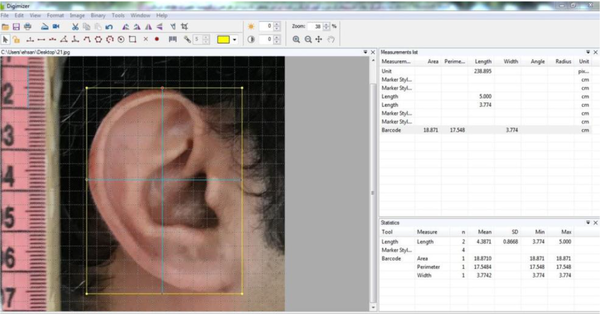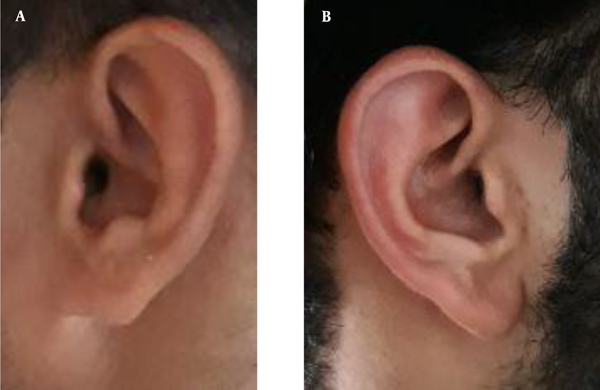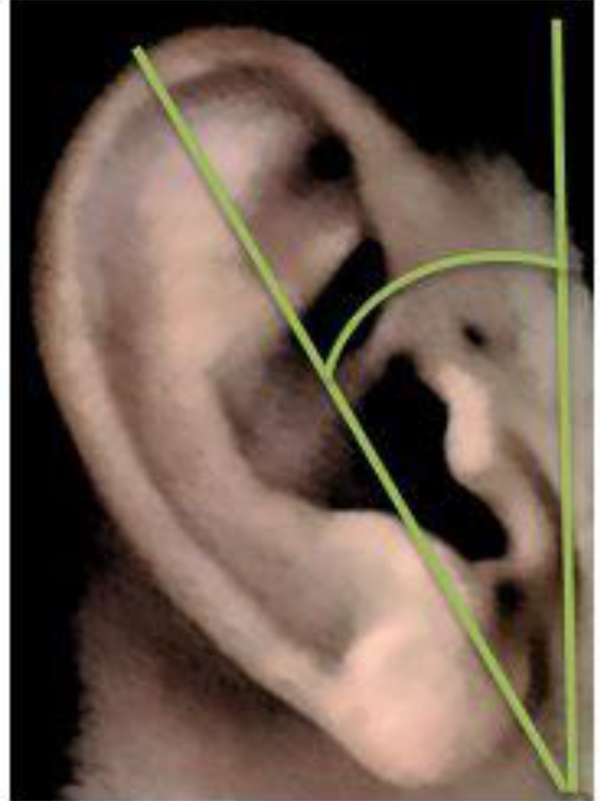1. Background
The external ear is of considerable importance for hearing (1). Unlike other organs with a growing limit to adulthood until the age of 20, the ears grow even after this age (2). The size and shape of the ear depend on parameters like age, sex, ethnicity, and even lifestyle (3-5).
Anthropometry, as a branch of science that studies body dimensions (6-8), can play a crucial role in examining the ears (9, 10). The dimensions of the external ear are of great importance in various fields of science, such as medical sciences (diagnosis and treatment) (11), cosmetic surgery (12, 13), criminology (14), and especially in the ergonomic design of ear-related products (15), like hearing aids (as medical devices) (16), headphones and earphones (listening device) (2, 17), and earmuffs and earplugs (personal protective equipment) (18). The ergonomic design aims to maximize compatibility between the product and the end-user by preventing damage caused by the inappropriate design of products to the users' body, creating ease of use and product stability (19-21). Personal protective equipment, particularly hearing protection devices (HPDs), must be used throughout the working time to have 100% efficiency (22, 23).
HPDs are divided into three main types of earmuffs, earplugs and semi-insert earplugs (24). Earmuffs are known as common HPDs that are used in the workplace. Two important dimensions in the design of earmuffs include the length and width of the pinna. In the earmuffs, the cushion should completely enclose the external ear and also cover it; however, it should not be very large. Various studies have been performed to measure the dimensions of the external ear in different countries, races, and ethnicities. For example, in a study performed in Turkey, Bozkir et al. showed that men's ear lengths and widths were greater than those of women (25). Purkait measured the shape, angle, and linear dimensions of the external ear of Indian men aged 18 - 70 years and indicated that almost all linear dimensions of the ear increased with age (14). Jung and Jung examined the anthropometric ear dimensions in different ethnic groups at different ages and in both genders and assessed the ergonomic design of ear-related products. Their results showed that the dimensions of earmuffs were smaller than those of Korean external ear of men (2).
Few studies have been conducted on the ear dimensions in Iran.
Rayegan et al. (26) assessed young men and women (aged 20 - 30 years) living in Kerman and showed significant differences between the width of the ears of men and women. Moreover, a literature review revealed only one study on ear dimensions among Iranian workers, with no detailed comparisons between ethnicities (18). As various ethnicities live in Iran, there is an urgent need to measure the anthropometric dimensions of different ethnicities. Tehran is the capital city of Iran, in which a diverse population from various ethnicities is working in industries located around this city.
Among the different ethnicities, two ethnicities of Fars (65 - 60%) and Turk (16%), constitute the largest share of the Iranian population (20, 27). Therefore, ear dimensions, shape, angle, and head length, and breadth of Fars and Turk workers were studied in this study.
2. Objectives
The aim of this study was to determine the anthropometric characteristics of the external ear and head of Iranian Turk and Fars workers for the ergonomic design of earmuffs.
3. Methods
Following a cross-sectional design, 300 Iranian male workers (20 - 60 years) from two ethnicities of Fars (n = 150) and Turk (n = 150) working in factories located in Tehran province were studied. Participants were randomly selected from different companies. Those in the Fars group were from different cities of Mashhad, Yazd, Shiraz, Isfahan, Tehran, and Bandar Abbas, whereas the subjects in the Turk group were from cities of Ardabil, West Azerbaijan, East Azerbaijan, and Zanjan. The subjects for each ethnicity were selected from parents and two generations before the same ethnicity. The exclusion criteria were a history of ear surgery, sports fracture, as well as ear disease, and anomalies. Before starting the anthropometric measurement, all participants completed the consent form.
The minimum sample size was determined according to the standard formula of ISO 15535, 2012 (28, 29).
Where, n is the minimum sample size, α is the percent of relative accuracy, and CV indicates the coefficient of variation. In the present study, α was equal to 2, and CV, based on a pilot study on 30 workers, was considered as 8. A minimum sample size of 145 was obtained for each ethnicity; however, the final sample size for each group was determined to be 150 subjects (300 ears).
3.1. Measuring Tools
A digital scale (PH-2015A) with an accuracy of 100 g was used to measure the weight. The stature of the subjects was measured using a tape measure (TM1701) with an accuracy of 0.1 cm. The head dimensions were measured with a spreading caliper. The ear dimensions were measured using a SUMSONG ES95 camera and a camera stand.
3.2. Measurement Method
Before measuring the anthropometric dimensions, the method and purpose of the study were described to all participants. Next, the height and weight of each subject were measured by application of a tape meter and digital scale. In order to measure the head and ear dimensions, participants were seated on an adjustable chair in the standard sitting position, while their heads were in the Frankfurt position. The maximum head length and breadth were measured using a spreading caliper, according to the Gary protocol (30). To measure the dimensions and morphology of the ears of participants, the camera was fixed on a tripod at a distance of 30 cm to the center of the external ear in the middle of the camera lens (15). A ruler beside the external ear was used to calibrate the photos. Photos taken using the camera were imported to the Digimizer V5.3.5 software, and the anthropometric dimensions of the ear were extracted (Figure 1).
3.3. Statistical Tests
Anthropometric data were analyzed by SPSS software version 21. Descriptive statistics (mean, standard deviation, and percentile) were measured for the anthropometrical dimensions. A paired t-test was used to compare the mean values between the left and right ear dimensions. The difference between the mean anthropometric dimensions of workers of two ethnicities was determined by the independent-samples t-test. Statistical significance was considered when P-value < 0.05. Also, the correlation between data was analyzed by the Pearson correlation analysis.
4. Results
The mean age of Turk and Far workers was 33.51 ± 5.41 and 33.95 ± 6.05 years, respectively. The ear lobules shape of 72% of Turk participants was free form and was attached in 28%. Regarding Fars workers, 76% had free, and 24% had attached lobules (Figure 2A and B).
Table 1 shows the different shapes of the ears between the two ethnicities; in both ethnicities, the ear shape was oval in more than half of the subjects. Comparison of the mean head breadth showed a significant difference between Turk and Fars ethnicity workers. However, there was no significant difference between the two groups concerning pinna length and width.
| External Ear Shapes | Fars | Turk |
|---|---|---|
| Oval | 63 | 66 |
| Round | 16 | 10 |
| Triangular | 12 | 13 |
| Rectangular | 9 | 11 |
External Ear Shapes in Fars and Turk Workers (%)
The results showed that 13.64% and 12.20% of Turk and Fars workers had an ear inclination angle greater than 25 degrees, respectively (Table 2 and Figure 3).
| Ethnicity | < 5° | 5 - 10° | 10 - 15° | 15 - 20° | 20 - 25° | 25° < |
|---|---|---|---|---|---|---|
| Fars | 29.27 | 13.41 | 15.51 | 19.85 | 9.76 | 12.20 |
| Turk | 36.36 | 9.09 | 11.36 | 13.64 | 15.91 | 13.64 |
The Frequency Distribution of Two Ethnicities in Different Auricular Inclination Angles (%)
Examination of the anthropometric dimensions of the head and ears (Table 3) showed that the mean breadth and length of the head of Turk workers was larger than Fars workers. Nevertheless, the length of external ears in Fars workers was larger than that of Turk workers.
| Variables | Fars | Turk | P-Value |
|---|---|---|---|
| Age (y) | 33.95 ± 6.05 | 33.51 ± 5.41 | 0.34 |
| Weight (kg) | 77.21 ± 14.40 | 86.11 ± 24.23 | 0.41 |
| Stature (mm) | 1737.0 ± 73.1 | 1758.0 ± 76.2 | 0.12 |
| Head length (mm) | 189.1 ± 8.8 | 193.0 ± 10.7 | 0.57 |
| Head breadth (mm) | 147.5 ± 7.5 | 154.6 ± 10.1 | 0.01 |
| Pinna length (mm) | 65.4 ± 5.0 | 64.1 ± 3.8 | 0.08 |
| Pinna width (mm) | 38.3 ± 3.1 | 39.2 ± 3.4 | 0.54 |
Comparison of the Variables in Two Fars and Turk Ethnicities a
The correlation between length and width of the pinna with age is shown in Tables 4 and 5. In both ethnicities, there was a positive correlation between pinna length and width and age. The older the age, the higher the dimensions of the ear.
| Variables | Age | Stature | Weight | Head Length | Head Breadth | Pinna Width |
|---|---|---|---|---|---|---|
| Stature | ||||||
| Pearson correlation | -0.046 | |||||
| P-value (2-tailed) | 0.630 | |||||
| Weight | ||||||
| Pearson correlation | 0.134 | 0.440 b | ||||
| P-value (2-tailed) | 0.161 | 0.000 | ||||
| Head length | ||||||
| Pearson correlation | 0.099 | 0.242 a | 0.430 b | |||
| P-value (2-tailed) | 0.302 | 0.010 | 0.000 | |||
| Head breadth | ||||||
| Pearson correlation | 0.191 a | 0.100 | 0.479 b | 0.396 b | ||
| P-value (2-tailed) | 0.045 | 0.296 | 0.000 | 0.000 | ||
| Pinna width | ||||||
| Pearson correlation | 0.284 b | 0.246 b | 0.359 b | 0.266 b | 0.116 | |
| P-value (2-tailed) | 0.003 | 0.009 | 0.000 | 0.005 | 0.224 | |
| Pinna length | ||||||
| Pearson correlation | 0.391 b | 0.024 | 0.211 a | 0.323 b | 0.227 a | 0.227 a |
| P-value (2-tailed) | 0.001 | 0.805 | 0.026 | 0.001 | 0.017 | 0.016 |
The Correlation Coefficient Between Variables for Fars Workers
| Variables | Age | Stature | Weight | Head Length | Head Breadth | Pinna Width |
|---|---|---|---|---|---|---|
| Stature | ||||||
| Pearson correlation | -0.177 | |||||
| P-value (2-tailed) | 0.062 | |||||
| Weight | ||||||
| Pearson correlation | -0.074 | 0.012 | ||||
| P-value (2-tailed) | 0.440 | 0.903 | ||||
| Head length | ||||||
| Pearson correlation | 0.026 | 0.098 | -0.011 | |||
| P-value (2-tailed) | 0.786 | 0.305 | 0.905 | |||
| Head breadth | ||||||
| Pearson correlation | 0.170 | 0.091 | 0.088 | 0.568 b | ||
| P-value (2-tailed) | 0.075 | 0.340 | 0.361 | 0.000 | ||
| Pinna width | ||||||
| Pearson correlation | 0.165 a | 0.209 a | -0.131 | 0.417 b | 0.244 b | |
| P-value (2-tailed) | 0.048 | 0.028 | 0.171 | 0.000 | 0.010 | |
| Pinna length | ||||||
| Pearson correlation | 0.322 b | 0.160 | 0.069 | 0.304 b | 0.308 b | 0.399 b |
| P-value (2-tailed) | 0.001 | 0.093 | 0.471 | 0.001 | 0.001 | 0.000 |
The Correlation Coefficient Between Variables for Turk Workers
Turk and Fars workers' ear length and width were positively correlated with head breadth and length, indicating that workers with larger heads have larger ears. Additionally, there was a positive and significant correlation between pinna length and width in workers of both ethnicities.
5. Discussion
In general, measuring the anthropometric dimensions of the ear, in comparison to other organs, is neglected by ergonomics experts. However, ears not only are members of different shapes and sizes but also vary in different ethnicities (31). Chattopadhyay and Bhatia (32), showed that the ears of approximately 36% and 64% of the studied participants were vertical and oblique, respectively. However, in our study, 29.27% of Fars workers had an ear inclination angle of fewer than 5 degrees and almost vertical. The angles of the ears relative to the perpendicular line can lead to the inappropriate matching of the earmuffs without adjustable headband to ears, which enforces workers to put the headbands angularly on their heads, leading to the lack of convenience of users and reducing the earmuffs’ usability.
Examination of the shape of the ears between the two ethnicities showed that 63% of Fars male workers had oval shape ears, and 66% of Turk male workers had oval shape ears. These results showed that the ellipse shape is the best for the inner ring of the earmuffs.
Sadeghi et al. (20) found a statistically significant difference between workers of six different Iranian ethnicities in terms of head length and breadth (P <0.05). In our study, there was also a significant difference (P <0.05) between head breadth in Fars and Turk male workers. It indicates the importance of considering the ethnicity of the users when designing the ergonomic of the headband for earmuffs, hamlets, and other head-related products.
In addition, the width of the pinna in Turk male workers was greater than that of the Fars workers. The survey of the symmetry between left and right ears showed a significant difference in the width of the pinna in Fars male workers between the two sides of the head (P <0.05). There was no significant difference between the length and width of the left and right ears in Turk workers (Table 6). Mououdi et al. reported that only the width of the left and right ears was significantly different, and there was no significant difference between the length of the earhole and pinna between the left and right ears in workers (18).
| Variables | Paired Differences (Mean ± SD) | P-Value (2-tailed) | ||
|---|---|---|---|---|
| Fars | Turk | Fars | Turk | |
| Pair 2: Left pinna length-right pinna length | 0.00541 ± 0.10787 | 0.13137 ± 0.70668 | 0.762 | 0.190 |
| Pair 1: Left pinna width-right pinna width | 0.05946 ± 0.14806 | 0.04510 ± 0.66882 | 0.020 | 0.632 |
Differences Between the Length and Width of the Pinna of Both Ears in FARS AND Turk Workers
Since earmuffs must cover the ears of the majority of users, the 95th percentile of the study population was used to design the dimensions of the earmuffs. In this study, the 95th percentile of pinna length and width in Fars workers was 72.2 and 43.5 mm, and in Turk workers was 71.4 and 44.8 mm, respectively (Table 7). The average dimensions (small and large diameters of the inner ring) of five brands of the most common earmuffs used in industries were 41.6 and 67.8 mm, respectively. Comparison of the ear dimensions measured in both ethnicities demonstrated that both dimensions of earmuffs are smaller than the 95th percentile of ear dimensions. A study on Taiwanese men and women in 2008 showed that the mean length of men's ears was 58.4 mm, being shorter than both Fars and Turk workers in this study. This study showed that the inner diameter of the earmuffs was smaller than the 95th percentile of Taiwanese male ears by 16 mm (15).
| Dimension | No. | Mean ± SD | 5 | 10 | 25 | 50 | 75 | 90 | 95 |
|---|---|---|---|---|---|---|---|---|---|
| Head length (mm) | |||||||||
| Fars | 150 | 189.1 ± 8.8 | 175.1 | 179.8 | 182.5 | 189.0 | 194.5 | 200.1 | 204.2 |
| Turk | 150 | 193.0 ± 10.7 | 176.3 | 180.0 | 185.0 | 193.3 | 199.2 | 205.5 | 207.1 |
| Head breadth (mm) | |||||||||
| Fars | 150 | 147.5 ± 7.5 | 133.2 | 136.5 | 140.4 | 146.5 | 155.8 | 161.2 | 164.3 |
| Turk | 150 | 154.6 ± 10.1 | 142.5 | 145.0 | 151.5 | 154.0 | 160.5 | 162.7 | 164.5 |
| Pinna length (mm) | |||||||||
| Fars | 300 a | 65.4 ± 5.0 | 57.5 | 59.4 | 61.5 | 65.8 | 68.2 | 71.7 | 72.2 |
| Turk | 300 a | 64.1 ± 3.8 | 59.2 | 60.5 | 62.5 | 64.5 | 67.7 | 69.6 | 71.4 |
| Pinna width (mm) | |||||||||
| Fars | 300 a | 38.3 ± 3.1 | 33.4 | 35.0 | 36.5 | 38.3 | 40.0 | 41.8 | 43.5 |
| Turk | 300 a | 39.2 ± 3.4 | 34.0 | 35.5 | 37.0 | 41.0 | 42.5 | 44.2 | 44.8 |
Anthropometric Dimensions of Both Ear and Head of Two Ethnicities (mm)
Mououdi et al. (18) measured the ear dimensions of male workers employed by the oil refinery, and the mean pinna length and width of men was 62.8 and 34.8 mm, respectively; while in our study, the mean pinna length and width of the Turk ethnicity was 64.1 mm and 39.2 mm and for Fars ethnicity was 65.4 mm and 38.3 mm, respectively (Table 7).
In the study by Fan et al. (33), the 95th percentile of ear length and width of 350 Chinese men aged 15-90 years was 75.35 and 42.39, respectively. In comparison to our study, their external ear length was greater than the external ear length of male workers of both Fars and Turk ethnicities, and their external ear width was smaller than that of workers of both ethnicities.
Liu (15) only considered the pinna length to investigate the fitness of the earmuffs and headphones and the user's ears. However, we believe that due to the different shapes of the ear, considering the width of the external ear in the design of hearing protection equipment is of great importance from both ergonomic and hearing protection perspectives.
5.1. Conclusions
This study demonstrated that there was no significant difference between the anthropometric dimensions of the external ear and the head of the two ethnicities of Fars and Turks except for the head breadth. Based on the comparison of anthropometric dimensions of external ear of workers of two ethnicities with the average dimensions of earmuffs in this study.
It is recommended that industrial designers, occupational health experts, and other relevant professionals pay special attention to the anthropometric dimensions of the external ear of the users when designing or selecting earmuffs.
Furthermore, there was a significant difference between the different genders according to the results of other studies on ear dimensions (10, 25). The authors suggest investigating the ear dimensions of Iranian women from different ethnicities to design appropriate earmuffs in future studies.




